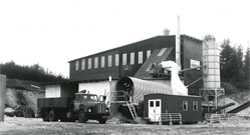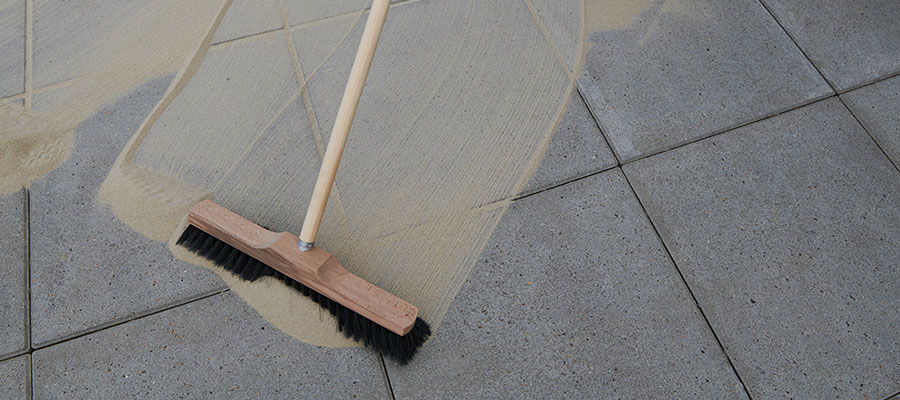

Nutrient-poor filling sand for narrow joints


Additional information
| Responsible: | |
|---|---|
| E-mail: | |
| Producer: | |
| Product designation: | Washed, kiln-dried and sorted silica sand with added minerals |
| Tel: | |
| Item number: | |
| Variant: | Anthracite, Grey, Nature |
| Variants: | Anthracite – 600015, Grey – 600016, Nature – 600413 |
Description
DANSAND® joint filling sand is easy to use and durable. The product is dried and based on fine round-edged silica sand, which makes it easy to distribute in the joints. DANSAND® joint filling sand has an optimal grain curve, which means that the material packs well in the joints. It provides stable, durable and flexible joints. The joint material is well suited for both new joints and renovation of coatings of natural stone or concrete. It can, for example, be on the terrace, walkways or in driveways with light traffic.
The NO GROW mixture consists of washed and dried silica sand as well as nutrient-poor minerals with a high pH value. The high pH value causes weed seeds to dry out so that they cannot take root and germinate – in a completely natural way. The minerals dissolve slowly and can only be washed out after 10 years of rain. With the correct use of DANSAND® joint filling sand, you get a great result that lasts for many years.
DANSAND® joint filling sand is available in gray, dark and natural colours.
Our coverage calculator helps you calculate the consumption of joint filling material. Estimated amount needed is approx. 20 kg for 5-10 m2.
Benefits of Dansand® joint filling sand:
- Washed and oven-dried silica sand with added minerals
- Natural high pH creates nutrient-poor growth environment
- Water permeable
- Easy to sweep into the joints
- Provides stable, durable joints
- For joints up to 5 mm
- Effective at a joint height of min. 40 mm
Specifications
Declaration
Joint material of round-grained, washed and oven-dried silica sand. A high pH mineral additive has been added. Available in natural, gray and dark. The joint material is ready-mixed and can be used directly from the bag.
Packaging
Frost-proof foil. Plastic bags made of PP material.
Storage
The bags can be stored outdoors during the summer. However, we recommend a covered storage location, as the plastic foil will not withstand heavy rain. In winter, the bags must be stored in a dry place. Open bags must be closed after use.
Security
Safety data sheets can be obtained at this link.
Delivery
20 kg in frost-resistant foil bag.
Environmental information and disposal
The joint material is not classified as dangerous according to the Danish Ministry of the Environment’s rules for classification and marking. Residues are handed in at a recycling station. The joint material must not be poured into the sewer. The plastic bags are made of PP material. Place in a container for combustible waste or for recycling.
The authorities’ requirements for the establishment, maintenance and grouting of fortified areas may vary nationally and locally. Therefore, familiarise yourself with the applicable national and / or local regulations before starting the joint work.
| Grain size | 0-1.5 mm |
|---|
Manual
Application
For new and existing paved surfaces of concrete and natural stone. Only to be used for outdoor use on a dry surface. Only suitable for an unbound base layer. Suitable for private use. Estimated consumption: 20 kg for approximately 5-10 m2. For 14x21x5 cm paving stones with a joint width of 2–3 mm = 2.0 kg / m2. Our coverage calculator helps you calculate the consumption of joint filling material. The filling depth must be at least 40 mm. The joint width must vary between 1-5 mm.
Here’s how you do it
Paving stones must be laid on a sustainable gravel and sand layer in accordance with current standards for paving work. The joint material is water-permeable like ordinary joint sand. Therefore, the base layer must also be water-permeable.
Repointing
DANSAND® filling sand is not a remedy for weeds. To prevent existing weeds from growing, all weeds – including weed roots – must be removed before refilling the joints. Clean the joint to a depth corresponding to the entire height of the stone. This is done using a joint cleaner. You can also use a high-pressure cleaner, but be careful not to damage the paving stones or the sublayer. Top up the joint.
Maintenance
To avoid weeds and displacements in the paving, the joint must always be filled to the full height of the joint edge and be completely free of soil and other organic material. The paving is cleaned with a stiff broom and the joints are refilled as needed. Moss and algae can be removed by suitable means. Extreme weather conditions can cause white deposits (efflorescence) in the joints and on the edges of the paving stones. However, they are usually washed off at the next rain shower. The deposits can also be removed by regular cleaning of the stones.
Please note
- The joint material must not be used in the joint directly against a plinth or other masonry. Use neutral joint filling sand here, as otherwise there is a risk of efflorescence or peeling
- Not suitable for bricks, tiles and porous natural stones
- Efflorescence can occur when the material is used under covered areas (carports, etc.). This can be removed with water or a broom. Efflorescence under covered areas will eventually disappear completely as the excess salts from the minerals decrease
| Step 1 | |
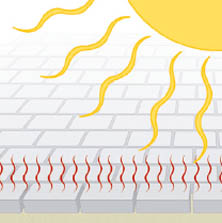 | The paving must be completely dry. |
| Step 2 | |
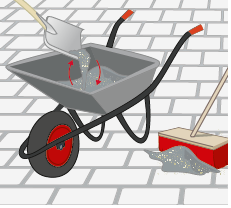 | Mix the filling material in a bucket or a wheelbarrow using a shovel to mix the mineral additives with the silica sand. Never mix the contents from more than two bags at a time. |
| Step 3 | |
 | Sweep the filling materials into the joints using a soft broom. Sweep in a diagonal pattern until the joints are filled to the top. |
| Step 4 | |
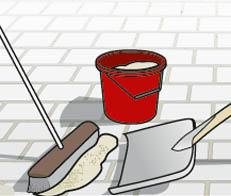 | Sweep the paving surface with a soft broom until clear of all excess stone dust. The stone dust may leave a grayish residue which will wash off when it rains. |
| Step 5 | |
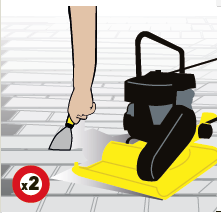 | If the paving is new, vibrate twice using a protective rubber mat on the vibrating plate to avoid damage to the paving surface. |
| Step 6 | |
 | Check that the joint is compacted well using a spatula. You should not be able to press the spatula more than a few millimetres into the joint. Refill if necessary and sweep the paving surface clear of filling sand. NOTE: Never use Dansand joint filling sand in the joint directly adjoining the plinth to avoid efflorescence and plaster cracking. Apply a neutral filling sand or other sand types in the joint adjoining the plinth. |
Vejledning og gode råd

Beregn, hvor meget fugemateriale, du skal bruge. Uanset om du skal fuge en ny belægning, eller blot skal fylde de eksisterende fuger op, er der hjælp at hente her på siden.
Her har vi samlet vores bedste råd til, hvordan du kan opnå de bedste resultater med vores effektive fugeprodukter. Hvilket fugemateriale skal jeg vælge?



